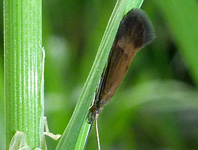Abstract
Dendropsophus cruzi (Pombal & Bastos, 1998) is a small hylid (male snout-to-vent length = 16.3–19.4 mm; female SVL = 21.3–25.0 mm) that is allocated in the D. microcephalus group (Faivovich et al. 2005). It is commonly found in Open and forested areas from Central Brazil to Provincia Velasco, Departamento de Santa Cruz, Bolivia (Frost 2017; Tessarolo et al. 2016). Pombal & Bastos (1998) described the advertisement call of D. cruzi as a single pulsed note. Posteriorly, studies uncovered relationships between dominant frequency variation in the advertisement calls of D. cruzi and variation in the SVL and mass of males (Bastos et al. 2003), as well as the existence of a clinal geographic pattern in the variation of acoustic parameters of these calls (Tessarolo et al. 2016). However, the acoustic communication in anurans is usually mediated by more than one vocalization type (Toledo et al. 2015). Due the importance of call types in the social context of anurans (e.g., Reichert 2011; Forti et al. 2017), we expand the vocal repertoire of D. cruzi by describing its aggressive call.
References
Bastos, R.P., Bueno, M.A.F., Dutra, L.P. & Lima, S.L. (2003) Padrão de vocalização de anúncio em espécies de Hylidae (Anura) do Brasil central. Comunicação do Museu de Ciencias Tecnologicas da PUCRS, 16, 39–51.
Bioacoustics Research Program (2011) Raven Pro: Interactive Sound Analysis Software. Version 1.4. The Cornell Lab of Ornithology, Ithaca, New York. [software]
Faivovich, J., Haddad, C.F.B., Garcia, P.C. de A., Frost, D.R., Campbell, J.A., & Wheeler, W.C. (2005) Systematic review of the frog family Hylidae, with special reference to Hylinae: a phylogenetic analysis and taxonomic revision. Bulletin of the American Museum of Natural History, 294, 1–240.
https://doi.org/10.1206/0003-0090(2005)294[0001:SROTFF]2.0.CO;2Forti, L.R., Forti, A.B.B.S., Márquez, R. & Toledo, L.F. (2017) Behavioural response evoked by conspecific distress calls in two neotropical treefrogs. Ethology, 123 (12), 942–948.
https://doi.org/10.1111/eth.12693Frost, D.R. (2017) Amphibian Species of the World: An online reference. Version 6. American Museum of Natural History, New York. Available from: http://research.amnh.org/herpetology/amphibia/index.php (accessed 15 February 2017)
Lingnau, R., Guimarães, L.D. & Bastos, R.P. (2004) Vocalizações de Hyla werneri (Anura, Hylidae) no sul do Brasil. Phyllomedusa, 3, 115–120.
https://doi.org/10.11606/issn.2316-9079.v3i2p115-120Pombal, J.P. Jr. & Bastos, R.P. (1998) Nova espécie de Hyla laurenti, 1768 do centro-oeste brasileiro e a posição taxonômica de H. microcephala werneri Cochran, 1952 e H. microcephala meridiana B. Lutz, 1952 (Anura, Hylidae). Boletim do Museu Nacional, 390, 1–13.
Reichert, M.S. (2011) Aggressive calls improve leading callers’ attractiveness in the treefrog Dendropsophus ebraccatus. Behavioral Ecology, 22, 951–959.
https://doi.org/10.1093/beheco/arr074Sueur, J., Aubin, T. & Simonis, C. (2008) Seewave, a free modular tool for sound analysis and synthesis. Bioacoustics, 18, 213–226. https://doi.org/10.1080/09524622.2008.9753600
Schwartz, J.J. & Wells, K.D. (1985) Intra- and interspecific vocal behavior of the neotropical treefrog Hyla microcephala. Copeia, 1985, 27–38. https://doi.org/10.2307/1444787
Tessarolo, G., Maciel, N.M., Morais, A.R. & Bastos, R.P. (2016) Geographic variation in advertisement calls among populations of Dendropsophus cruzi (Anura: Hylidae). Herpetological Journal, 26, 219–224.
Toledo, L.F., Martins, I.A., Bruschi, D.P., Passos, M.A., Alexande, C. & Haddad, C.F.B. (2015) The anuran calling repertoire in the light of social context. Acta Ethologica, 18, 87–99.
https://doi.org/10.1007/s10211-014-0194-4

